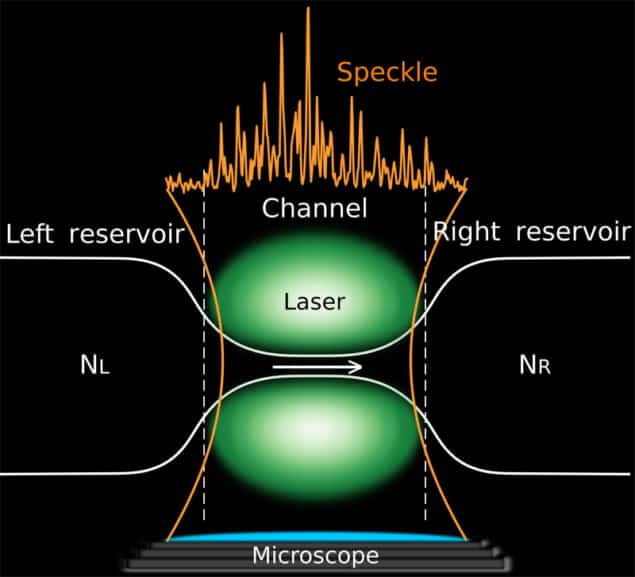
Physicists in Switzerland are the first to use ultracold atoms to simulate one of the most technologically important properties of solid matter: electrical conduction. The experiment involves watching lithium atoms as they pass through a tiny channel created by laser light. The team has shown that atoms that travel straight through a channel without experiencing any disorder display ohmic conduction, just as atoms that bounce their way through a disordered channel.
Ensembles of ultracold atoms have been used to simulate a wide range of condensed-matter physics including aspects of magnetism and superconductivity. Atomic gases can provide important insights into the quantum nature of matter because, unlike the electrons in a solid, the interactions between ultracold atoms can be controlled precisely using laser light and magnetic fields.
In principle, electrical conduction could be simulated by allowing ultracold atoms to move through a channel from one reservoir to another. By measuring the change in density of the gas as it passes through the conducting region, physicists could study the conduction process in ways that are not possible with real conductors. This would be of particular interest to those designing extremely small electronic circuits where quantum effects can play an important role in conduction.
Watching the channel
In addition to creating such a system, imaging the conduction region has also proven to be difficult – and now both of these challenges have now been overcome by Tilman Esslinger and colleagues at ETH Zürich. The team used a microscope objective to obtain high-resolution images of a conduction channel that is about 18 µm wide and about 30 µm long. The channel is created by focusing a laser into two lobes – with the channel existing in the dark region between the lobes.
The channel separates two reservoirs that are filled with a gas of about 40,000 lithium-6 atoms that has been cooled to 250 nK. A magnetic field gradient is applied to the system during the cooling process, which results in a higher density of atoms in the reservoir on the right than on the left.
The field gradient is then switched off and atoms begin to conduct through the channel from right to left. An important property of the gas is that the average distance an atom travels before it collides with another atom is more than 40 times the length of the channel. This means that most atoms will fly straight through the channel like bullets – and this ballistic conduction is something that is believed to occur in tiny conductors such as carbon nanotubes.
Ohm’s law for atoms
Esslinger and team first focused on this ballistic case and found that conduction occurred in a manner analogous to ohmic electrical conduction – that is, the rate at which atoms move from one reservoir (analogous to electrical current) is proportional to the difference in the numbers of atoms in each reservoir (analogous to electrical voltage) and a constant that is related to the conductance of the channel. This analogy is strengthened by the fact that, like the electron, lithium-6 is a fermion. This means that at low temperatures the energy levels of the gas resemble that of an ensemble of electrons.
Ohmic conduction is expected when atoms jostle their way through a disordered channel scattering in a diffusive manner. Therefore it might – at first glance – seem strange that ohmic behaviour applies to ballistic atoms that don’t collide as they move through the channel. The key to understanding this, according to Esslinger, is thinking about what happens to the atoms at the boundary between the right reservoir and the channel. At this point, an atom can either fly straight through the channel or be reflected back in a quantum-mechanical process first described in 1957 by the German-American physicist Rolf Landauer.
So even though they don’t scatter as they travel through the channel, their scattering at the entrance results in an ohmic conductance. The behaviour was verified by using the microscope to measure the density of atoms throughout the channel. This revealed an abrupt change in density at the interface with the right reservoir and a relatively constant density throughout the channel. This confirms that most of the scattering occurs at the interface rather than in the channel.
Linear density drop
The team then repeated the experiment with the parameters of the channel changed so that diffusive scattering occurs. This is done by introducing laser speckle to the channel. Again the researchers measured ohmic behaviour, but with a different conductance constant. Microscope images reveal that the atomic density drops linearly along the channel – which suggests that the conduction is diffusive.
Now that they have performed the studies in an ultracold atomic gas, Esslinger and collegaues are keen to study ballistic conduction when the atoms interact with each other. This can be done by applying carefully selected magnetic fields to the atoms to create so-called Feshbach resonances.
The research is reported in Science.



